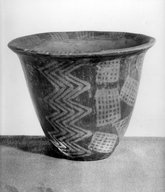The funeral procession on water
This fragment shows two scenes of funerary boats travelling to the right towards a booth under which are jars and a conical loaf. The boat in the upper register is propelled by four oarsmen; in the cabin at the front two persons are seen talking to each other. On top of the catafalque (?) five mourners are sitting, dressed in large white robes. In the lower register a person on the right takes hold of the prow of a boat rowed by four oarsmen. The boat is carrying several standing individuals: one man carrying
papyrus bouquets, another holding a large stick, another with a fan, and two men carrying ritual vessels, a funerary figurine, and a
shabti box. At the extreme right, beneath the upper booth, a servant is holding two jars on the ground.
Present location
| KMKG - MRAH [07/003] BRUSSELS |
Inventory number
| E.2380 |
Dating
| 18TH DYNASTY |
Archaeological Site
| UNKNOWN |
Category
| WALL PAINTING |
Material
| UNSPECIFIED MINERAL; PLASTER |
Technique
| PAINTED |
Height
| 74.5 cm |
Width
| 38 cm |
|
|
Bibliography
- L. Speleers, Recueil des inscriptions égyptiennes des Musées Royaux du Cinquantenaire à Bruxelles, Bruxelles 1923, 40 nº 154
- A. Mekhitarian, Fragments de peintures thébaines, Serapis 6 (1980) 88
- L. Manniche, Lost Tombs, Londres-New York 1988, 192-193
- J.-Ch. Balty, e.a., Koninklijke Musea voor Kunst en Geschiedenis, Brussel, Oudheid - Musées Royaux d'Art et d'Histoire, Bruxelles, Antiquité - The Royal Museums of Art and History, Brussels, Antiquity, Bruxelles 1988, 26-28
globalegyptianmuseum
 This item is not on view
This item is not on view






